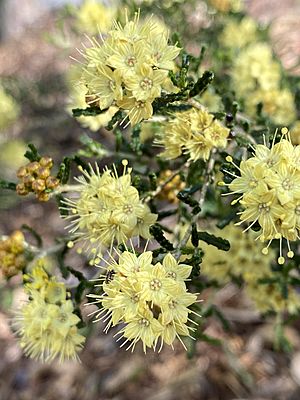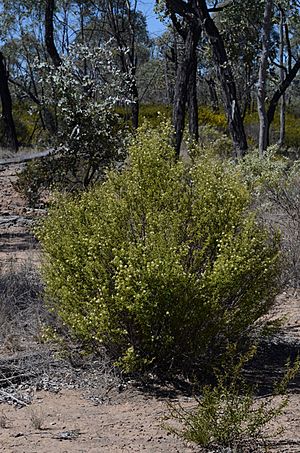Desert phebalium facts for kids
Quick facts for kids Desert phebalium |
|
|---|---|
 |
|
| Subspecies glandulosum in the ANBG | |
| Scientific classification | |
| Genus: |
Phebalium
|
| Species: |
glandulosum
|
| Synonyms | |
|
Eriostemon lepidotus var. glandulosus (Hook.) F.Muell. nom. inval., nom. nud. |
|

The Phebalium glandulosum, often called desert phebalium, is a special kind of shrub. It grows only in eastern Australia. This plant has bumpy stems covered in shiny, scale-like bits that can be silver or even rusty orange. Its leaves are shaped like a wedge, and its bright yellow flowers grow in neat clusters at the end of its branches.
Contents
What Does Desert Phebalium Look Like?
The desert phebalium is a shrub that usually grows to be about 0.5 to 2.5 meters (about 1.5 to 8 feet) tall. Its stems have tiny bumps, like warts, and are covered with lots of shiny scales. These scales can be silvery or a rusty color.
Leaves and Flowers
The leaves of this plant are shaped like a wedge. They are usually 3 to 30 millimeters (about 0.1 to 1.2 inches) long and 1 to 5 millimeters (about 0.04 to 0.2 inches) wide. Each leaf sits on a short stalk.
The desert phebalium has five to ten pale to bright yellow flowers. These flowers grow in clusters that look a bit like tiny umbrellas. Each flower sits on its own small stalk, which is about 2 to 7 millimeters long. The leafy part that protects the flower bud is about 1 to 1.5 millimeters long. It also has tiny bumps and scales on the outside. The petals of the flowers are about 2.5 to 3 millimeters long and overlap each other.
When Does it Bloom?
This shrub usually flowers in the spring. After flowering, it produces upright seed pods, called follicles, which are about 3 to 4 millimeters long.
How Was Desert Phebalium Named?
The desert phebalium was first officially described in 1848. An English botanist named William Jackson Hooker gave it its formal name. He wrote about it in a book called Journal of an Expedition into the Interior of Tropical Australia.
Later, scientists studied the plant more closely. They found that there are different types, or subspecies, of Phebalium glandulosum. These different types have slight variations, but they all belong to the same main species.
Where Does Desert Phebalium Grow?
You can find the desert phebalium in many places across eastern Australia. It grows in different kinds of environments, including open areas with low shrubs (called heath), forests, and areas with small, multi-stemmed trees (called mallee). It is found in the states of Queensland, New South Wales, Victoria, and South Australia.

